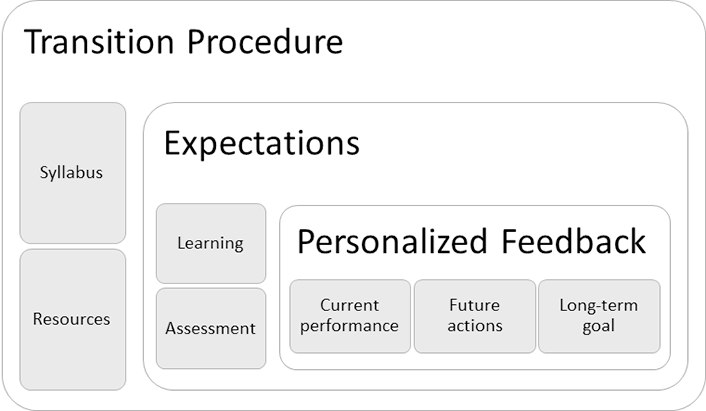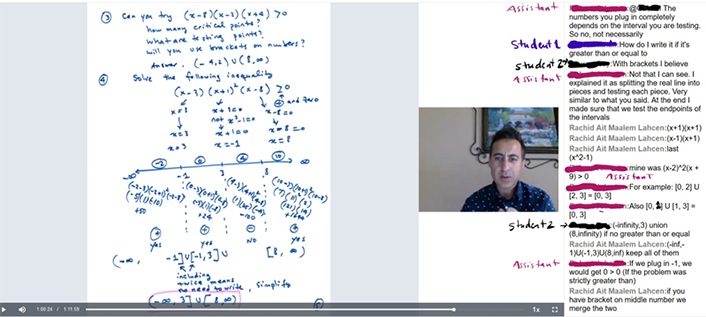Two strategies may help instructors successfully transition to remote teaching by using technology as a way to focus on the critical aspect of making human connections with students.

As we all know, the COVID-19 pandemic locked down higher education campuses and forced social distancing. Neither faculty nor students had access to their offices, computer centers, or books and printed references in the library. Face-to-face interaction between faculty and students quickly became a thing of the past.
In the spring of 2020, we surveyed our students about this significant change. A survey was delivered in each course via the learning management system (LMS). Several students reported that the sudden change to remote instruction was difficult due to lacking resources (e.g., a study space in their homes and new locations), being in a different time zone, missing instructors' online live sessions due to change in sleep patterns, not having in-person tutoring, and other problems. As we discussed in an article written before COVID-19, even students in face-to-face environments may avoid asking questions or requesting help.1 In addition, the sense of belonging to a class is a significant contribution to their learning, something that may now be lost.
Clearly, the instructor's role in this sudden change to remote instruction is challenging and requires a major rearrangement of strategies. Certain strategies will have a bigger impact in disseminating lessons effectively. But what should be prioritized?
According to Parker Palmer, teaching cannot be reduced to a technique: good teaching is based on a teacher's identity and integrity and on a teacher's capacity for connectedness.2 Likewise Rita Pierson has emphasized the importance of connecting with students and of how doing so can build a legacy that will never fade away.3 Principles that foster human connection are vital.
Here we will discuss two strategies that we used, after our campus closure, in two math courses: Mathematics for Calculus (5 credits) taught by Ram Mohapatra; and College Algebra (3 credits) taught by Rachid Ait Maalem Lahcen. Both use the same LMS and the same adaptive courseware for assignments. The two strategies aim to improve the use of technology by focusing on human connections as follows:
- Strategy 1: Personalizing Targeted Feedback
- Strategy 2: Embedding a Human Assistant in Online Virtual Instruction
Strategy 1: Personalizing Targeted Feedback
Mathematics for Calculus was already an online course prior to our campus closing, so the switch was natural—except for no longer holding tests and the final examination on campus. Students in this course were used to remote learning. Materials have already been designed, and the activities have been marked weekly with formative assessments and examples prearranged in a regulated way. However, we cannot assume that students in this course were immune to the negative impacts of the campus closure and of being away from their friends and study groups. A large majority of students in this course mentioned that not all their other courses were online before and that courses had to be quickly rearranged, with instructors who had neither the time nor the training to do so. Dr. Mohapatra noticed that students' activity in the course dropped after the campus closure. Hence, Strategy 1 was prioritized to monitor and provide comments on students' progress in a regular manner with constructive feedback on their activities.
According to Susan A. Ambrose and her co-authors, providing feedback about progress can have a powerful motivating effect.4 The authors define feedback as information that is given to students about their performance and that guides future behavior. Consequently, feedback is an important step that comes between observing a student's performance and guiding the student for better practice or behavior. Grant Wiggins discusses the essentials of feedback as follows:
- Goal-Referenced: feedback is an action to achieve a goal
- Tangible and Transparent: tangible results relate to the goal
- Actionable: it provides specific actionable information
- User-Friendly: the receiver sees its value and understands it
- Timely: it is not too late to adjust "the sooner the better"
- Ongoing: it provides an opportunity for the performer to apply feedback and reshape performance
- Consistent: standards are communicated correctly and are trustworthy5
Feedback can be addressed to a class, a subgroup, or individuals.
Effective feedback should be anchored to various elements of the instruction. Figure 1 shows the main components of personalized targeted feedback. The umbrella is an effective communication and sharing transition procedure with students. This includes updating the syllabus and announcing available resources (e.g., tutoring, counseling, library, advising, grading). Afterward, expectations should be articulated by showing that the instructor is available to listen to concerns about learning and assessment; however, students' efforts to learn and complete assignments are necessary to meet the expectations.
Lastly, personalized feedback is targeted at three components:
- What is the student's current performance?
- What actions should the student take in the near future?
- What long-term goal should the student aim for?
The first two questions were relatively easy for the instructor to answer with the assistance of the adaptive technology used in a course. To answer the last question, the instructor should communicate to students how the gap of knowledge can affect future assessments or subsequent courses and should talk to students about the program outcomes of the course. Instructors often present only course-specific learning outcomes and may fail to discuss the program in which the course belongs or in which the student is majored. Highlighting how students' learning in one course will contribute to their success in the program overall will greatly increase students' motivation.

Strategy 2: Embedding a Human Assistant in Online Virtual Instruction
College Algebra was a face-to-face class with 289 students meeting in a computer lab twice a week before the campus closed. Students received instruction from a lecture presented by a teaching assistant or the instructor and received individualized instruction on demand from undergraduate learning assistants or graduate teaching assistants. Graduate teaching assistants received pedagogy training from the instructor, and they attended a biweekly learning seminar in which various education subjects were discussed. Learning assistants were trained by both the instructor and a lab coordinator.
The sudden campus closure and switch to remote instruction was thus more complicated for this course. After the campus closing, students joined online live sessions—but as passive listeners. As a result, the instructor tried to encourage interactions in the new instructional space, and Strategy 2 was prioritized. The idea here—embedding a human assistant in the online virtual lectures and office hours—is based on Albert Bandura's social learning theory.6 The main part of this theory is that learning through modeling, or observational learning, may persuade students to imitate the assistant who is engaging in the lecture and to also answer questions and write comments. The assistant could be a graduate teaching assistant, an undergraduate student, or a peer leader. The results of this strategy have been satisfying. In the College Algebra survey conducted during the same term of transition (Spring 2020), students responded that having online conferences that were set up like face-to-face instruction was helpful during the remote teaching transition.
Figure 2 shows a snapshot from a virtual conference in which instruction was led by the instructor and facilitated by a graduate teaching assistant. Both the voice and the chat functions were enabled. Students in the chat were engaged in writing questions and answers, with the assistant's support. (The names of students and the assistant are concealed in figure 2 for privacy.)

The same strategy was used during the graduate teaching assistant's office hours (5 hours per week). The assistant was paired with an undergraduate learning assistant. Whereas the ratio of assistant-to-students had been 1:25 in the face-to face-class, it was either the same or better after the transition because students could attend live sessions and also watch recordings.
Final Thoughts
Remote instruction is certainly thought-provoking. Janet Mannheimer Zydney and her coauthors have discussed how several of the challenges of blended synchronous learning, such as technology, can be unpredictable and how instructors should prepare for the unexpected.7 In our case, we noticed the disadvantages caused by the loss of the visual and audio that is taken for granted in face-to-face settings. Facial expressions and verbal comments help us know if students are not understanding or are confused. In remote instruction, however, students often must turn off their webcams and mute their microphones to conserve limited connectivity bandwidth or to minimize visual and audio interruptions.
Another challenge is how an instructor's teaching style may be affected by the new educational setting.8 Here we have discussed two strategies that may help to adjust teaching styles to an unforeseen campus closure: personalizing targeted feedback (in the Mathematics for Calculus course) and embedding a human assistant for online synchronous learning sessions (in the College Algebra course). Students' feedback was consistently positive. They stated that online meetings were helpful, along with the option of online office hours. In addition, students felt that interaction with instructors had improved: "One thing that has been extremely helpful during this transition was the increase in communication from my professors." And students appreciated "teachers making an effort to reach out and adapt to students as much as students had to adapt to the online schedule."
In the Mathematics for Calculus course, we compared results between Spring 2019 and Spring 2020 to learn if we had mitigated potential negative effects of the sudden campus closure. In Spring 2019, 50 students were enrolled, with a pass rate of 92 percent; in spring 2020, 39 students were enrolled, with a pass rate of 100 percent. The assignments during both spring semesters were the same. Table 1 shows students' averages for all tests.
Table 1. Tests averages in Spring 2019 and Spring 2020, Mathematics for Calculus
|
|
Midterm Test 1 |
Midterm Test 2 |
Midterm Test 3 |
Final Test |
|---|---|---|---|---|
| Spring 2019 (N = 50) |
93% |
76% |
82% |
75% |
|
Spring 2020 (N = 39) |
90% |
76% |
80% (Remote |
88% (Remote |
| Difference |
-3% |
0% |
-2% |
+13% |
One difference between the two semesters was that open-notes tests (the midterm test 3 and the final test) were allowed during the remote instruction period in Spring 2020, whereas these had been closed-notes tests during Spring 2019. However, the tests were not the same. The open-notes tests contained more types of numeric entry, graph interpretation, and word problems. Interestingly, although the midterm test 3 in Spring 2020 was an open-notes test, the students' average was 2 percent lower than the average for the same test (closed-notes) in Spring 2019. Overall, students attributed their lower performance and their missed assignments to a drop in motivation after they had left campus. Later, after responding positively to the persistent personalized feedback from the instructor, they showed a better performance on the final test.
Unlike Mathematics for Calculus, the 2020 College Algebra course was a modified version of the 2019 course. The course design, exam questions, and explanations/lessons were updated based on students' data from the previous year. Again, we compared the course results solely to see if we had mitigated potential negative effects of the sudden campus closure. In Spring 2019, 289 students were enrolled in a College Algebra section, with a pass rate of 78 percent. In Spring 2020, 148 students were enrolled in a similar section, with a pass rate of 87 percent.
Although we did not develop a specific instrument to measure the effectiveness of these two strategies (due to the fast sequence of unfortunate events), we believe—based on students' consistently positive feedback and their overall success in the two courses—that prioritizing the strategies helped us avoid a bad situation. We also believe that most courses are already designed with the implementation of best teaching practices and that refining those strategies during an emergency can be fruitful. Of course, it can be stressful for instructors to figure out the best solution while handling their own personal challenges and learning new technologies as well. Therefore, we recommend the simple practice of surveying students about what worked and what did not work. As Grant Wiggins has stated, asking students such questions can reveal interesting patterns and can help educators improve their teaching skills.9
We look forward to investigating these strategies in the future, using better methodology and data analysis. Since events that interrupt the normal course of instruction can happen at any time and for a variety of reasons, we wanted to share our experience with other educators now. The major takeaway for us is that although technology can support our teaching, it is helpful to turn back to square one and use that technology to deliver responsive and flexible teaching, connect with students, and prioritize our support of one another as humans. While our students stated that technology aided the transition—for example, the use of the LMS was helpful—they emphasized that they also benefitted when instructors reached out to them, let them know what to do, and explained the available resources. Students appreciated the increase in feedback and the availability of human assistants during remote instruction. To paraphrase US President Theodore Roosevelt: "Students don't care how much you know until they know how much you care."
Notes
- Rachid Ait Maalem Lahcen and Ram Mohapatra, "Promoting Proactive Behavior through Motivation: Required Math Lab Hours Case," International Journal of Research in Education and Science (IJRES) 6, no. 1 (2020). ↩
- Parker J. Palmer, The Courage to Teach: Exploring the Inner Landscape of a Teacher's Life (San Francisco: Jossey-Bass, 1998). ↩
- Rita Pierson, "Every Kid Needs a Champion," TED Talk, May 2013. ↩
- Susan A. Ambrose, Michael W. Bridges, Michele DiPietro, Marsha C. Lovett, and Marie K. Norman, How Learning Works: 7 Research-Based Principles for Smart Teaching (San Francisco: John Wiley & Sons, 2010). ↩
- Grant Wiggins, "7 Keys to Effective Feedback," Educational Leadership 70, no. 1 (September 2012). ↩
- Edelgard Wulfert, "Social Learning According to Albert Bandura," Salem Press Encyclopedia of Health (2014). ↩
- Janet Mannheimer Zydney, Paul McKimmy, Rachel Lindberg, and Matthew Schmidt, "Here or There Instruction: Lessons Learned in Implementing Innovative Approaches to Blended Synchronous Learning," TechTrends 63, no. 2 (2019). ↩
- See Annelies Raes, Pieter Vanneste, Marieke Pieters, Ine Windey, Wim Van Den Noortgate, and Fien Depaepe, "Learning and Instruction in the Hybrid Virtual Classroom: An Investigation of Students' Engagement and the Effect of Quizzes," Computers and Education 143 (August 2019). ↩
- Grant Wiggins, "Giving Students a Voice: The Power of Feedback to Improve Teaching," Educational Horizons 89, no. 3 (Spring 2011). ↩
Rachid Ait Maalem Lahcen is an associate math instructor and college algebra coordinator at the University of Central Florida.
Ram Mohapatra is a mathematics professor and academic director at the University of Central Florida.
Baiyun Chen is a senior instructional designer and program director of Personalize Adaptive Learning at the University of Central Florida.
© 2020 Rachid Ait Maalem Lahcen, Ram Mohapatra, and Baiyun Chen
